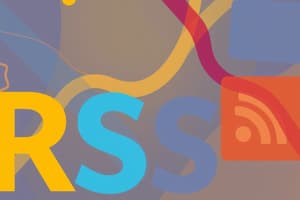Podcast
Questions and Answers
¿Cuál es un formato comúnmente aceptado por las plataformas de podcasting debido a su amplio soporte entre reproductores de hardware, computadoras, teléfonos y tabletas?
¿Cuál es un formato comúnmente aceptado por las plataformas de podcasting debido a su amplio soporte entre reproductores de hardware, computadoras, teléfonos y tabletas?
- AAC (Advanced Audio Coding)
- MP3 (MPEG Audio Layer III) (correct)
- FLAC (Free Lossless Audio Codec)
- WMA (Windows Media Audio)
¿Qué estrategia de distribución recomienda involucrarse con la audiencia a través de llamados a la acción para fomentar la interacción?
¿Qué estrategia de distribución recomienda involucrarse con la audiencia a través de llamados a la acción para fomentar la interacción?
- Crear contenido exclusivo (correct)
- Utilizar transcripciones y descripciones de episodios
- Optimizar para los motores de búsqueda
- Promocionar y comercializar tu programa
¿Qué tipo de contenido se recomienda ofrecer a los seguidores leales como una técnica de compromiso con la audiencia?
¿Qué tipo de contenido se recomienda ofrecer a los seguidores leales como una técnica de compromiso con la audiencia?
- Repetir el contenido principal
- Episodios más cortos
- Contenido exclusivo (correct)
- Material promocional
¿Qué tipo de archivos de medios no es mencionado como comúnmente aceptado en la industria del podcasting?
¿Qué tipo de archivos de medios no es mencionado como comúnmente aceptado en la industria del podcasting?
¿Qué estrategia clave se sugiere para garantizar que los oyentes que buscan palabras clave específicas puedan encontrarte más fácilmente?
¿Qué estrategia clave se sugiere para garantizar que los oyentes que buscan palabras clave específicas puedan encontrarte más fácilmente?
Flashcards are hidden until you start studying
Study Notes
Multimedia Distribution Through RSS Feeds and Podcasting Platforms
The world of multimedia distribution has been transformed by two key technologies—RSS feeds and podcasting platforms. These tools have made it easier for creators to share their work with large audiences around the globe. In this article, we'll explore how these systems work together to make content easily accessible to anyone, anywhere. We'll cover the basics of RSS feeds, popular podcasting platforms like Apple Podcasts and Spotify, effective distribution strategies, common media file formats used in podcasts, and ways to engage your audience effectively.
RSS Feed Basics
RSS stands for Really Simple Syndication, which is a format for delivering frequently updated content such as news headlines, blog posts, audio files, etc., from various sources to users who have chosen to subscribe to them. This means you can keep up with new episodes of your favorite shows without having to visit multiple websites. Instead, they come directly into your preferred aggregator software or mobile app when released.
Popular Podcasting Platforms
Several services offer hosting and distribution options for podcasters, allowing anyone to create and publish audio content online quickly. Some prominent ones include:
- Apple Podcasts: A free service owned by Apple Inc. where people can search for, discover, and listen to podcasts across iOS devices including iPhones and iPads.
- Spotify: Primarily known as a music streaming platform, Spotify also hosts thousands of podcasts. Creators can upload content via its web interface after signing up for a paid account.
Effective Distribution Strategies
To ensure your podcast reaches your target audience, here are some tips for effective distribution:
- Promote and Market Your Show: Share teasers and trailers on social networks before launching; partner with relevant influencers or organizations to help spread word about your show.
- Optimize for Search Engines: Title each episode appropriately so listeners searching specific keywords find you more easily.
- Utilize Transcripts and Episode Descriptions: Make sure transcripts exist for better indexability by major podcast directories like Google Play Music and Overcast.
- Engage with Listeners: Respond to feedback, ask questions during live recordings, and encourage conversation within your community.
Media File Formats Used in Podcasting
While there isn't one standard media file type used exclusively in podcasting, most platforms accept MP3 (MPEG Audio Layer III) due to its widespread support among hardware players, computers, phones, tablets, car stereos, etc.. Other commonly supported formats include M4A and WAV. However, it's essential to check individual directory requirements since they may vary slightly between providers.
Audience Engagement Techniques
For successful podcasting, engaging with your audience goes beyond distributing quality content. Consider incorporating strategies such as:
- Call-to-Action (CTA): Encourage interaction through invitations to submit questions, participate in discussions, or leave reviews.
- Interact on Social Media: Interact regularly with followers across different channels such as Facebook groups, Twitter handles, Instagram accounts, etc..
- Create Exclusive Content: Offer bonus material or behind-the-scenes insights only available to loyal supporters.
In conclusion, understanding RSS feeds, choosing appropriate podcasting platforms, implementing strategic distributions techniques, selecting suitable media file formats, and actively involving your audience are crucial elements of multimedia distribution success. With these tools at hand, everyone from professional broadcasters to aspiring amateurs now possesses the ability to reach wider audiences effectively.
Studying That Suits You
Use AI to generate personalized quizzes and flashcards to suit your learning preferences.




